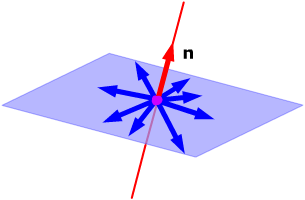
Suppose you have a 2-dimensional subspace of Euclidean 3-space, i.e. a plane through the origin with some normal vector n. All the vectors in 3-space orthogonal to this plane must then be parallel to n, so they form a 1-dimensional subspace of 3-space.

This sort of relationship also works in general inner product spaces - the vectors orthogonal to all vectors in one subspace always form another subspace.
|
| Proof. This is easy to check: look at the closure rules. |
| If u and
v are orthogonal to all vectors in W
, then for every vector w in W,
|
| If u is
a vector orthogonal to all vectors in W,
then for every vector w in W
and any scalar k, |
This new subspace has a name.
|
The word "complement" comes from the fact that the subspace W⊥ "complements" the subspace W, in the sense that both together give you all of V. More precisely:
|
Proof. (omitted) |
Some other properties of orthogonal complements.
| If W is a subspace of an inner product space V, then |
|
|
Proof. Any vector in both W and W⊥ must be orthogonal to itself. The only vector orthogonal to itself is the zero vector. |
|
|
Proof. (omitted) |
|
|
Proof. (omitted) |
Though orthogonality is essentially a geometric concept, there's a connection between orthogonal complements and the fundamental subspaces of a matrix.
|
||
|
Proof. Denote the rows of A by r1, r2, ..., rm. Any vector w in the row space of A i s a linear combination of r1, r2, ..., rm:
A vector x is in the null space of A if and only if it satisfies Ax = 0, so (since the multiplication Ax is the dot product of x with the rows of A), x is in the null space of A if and only if it is orthogonal to all the rows r1, r2, ..., rm. Then
Thus x is in the null space of A if and only if it is orthogonal to every vector in the row space of A. This says that the null space of A is the orthogonal complement of the row space of A. |
This last result can be used to find a basis of an orthogonal complement of a subspace of Rn if you are given a basis of the space itself.
| To find a basis of an orthogonal complement in Rn |
Given a basis {b1, b2, ..., bm} of a subspace W of Rn |
|
|
That basis will be a basis of W⊥ |